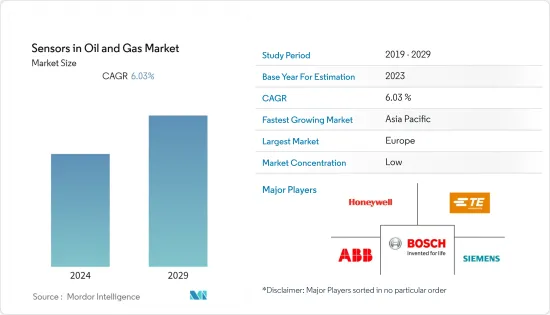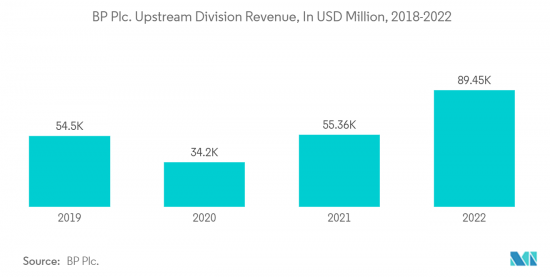 |
市场调查报告书
商品编码
1404425
石油和天然气感测器:市场占有率分析、行业趋势和统计、成长预测,2024-2029 年Sensors in Oil and Gas - Market Share Analysis, Industry Trends & Statistics, Growth Forecasts 2024 - 2029 |
||||||
※ 本网页内容可能与最新版本有所差异。详细情况请与我们联繫。
石油和天然气感测器市场规模预计将从2024年的99.7亿美元成长到2029年的133.6亿美元,预测期间(2024-2029年)复合年增长率为6.03%。

主要亮点
- 全球经济依赖石油和天然气产业。石油和天然气工业生产世界上大部分基本能源,也是多种化学产品的原料来源,包括农药、化肥、药品、溶剂和聚合物。控制和监测对于石油和天然气产业的高效稳定运作至关重要。提高生产力、降低成本并提高盈利。石油和天然气行业的控制和监控在很大程度上依赖感测器。
- 影响市场扩张的主要因素是对技术进步的日益关注和政府的支持政策。工业化的进步和各种安全和职业健康法规的收紧降低了市场价值。由于人们对空气污染的认识不断增强以及微型无线感测器供应的增加,该市场将会成长。推动市场快速成长的另一个因素是微机电领域的扩张和成长。
- 石油和天然气产业越来越多地采用工业物联网 (IIoT) 感测器,这主要是出于降低成本的需要。由于感测器製造商为最终用户提供的技术进步和简单的组装选项,这些感测器的安装既快速又便宜。
- 目前的油价环境正在推动整个石油和天然气产业发生重大变化并做出艰难的决策。需要改善资本支出和营运支出的新营运模式和策略,以因应中短期市场供需动态。对提高安全和环境绩效的永续解决方案的长期需求是重中之重。从钻台到炼油厂,感测器应用可协助营运商透过频谱上游、中游和下游创新和解决方案实现自身平衡。
- 感测器製造商越来越多地提供易于组装的感测器。技术进步加剧了主要感测器製造商和物联网产品服务供应商之间的竞争,推动了感测器在石油和天然气行业的采用。
- 此外,石油和天然气产业也面临技术纯熟劳工短缺的问题。人才库的薄弱使得石油和天然气公司僱用具有解决新能源来源所需技术技能的新员工的能力变得复杂。此外,COVID-19期间油价急剧上升以及沙乌地阿拉伯和俄罗斯等国家之间的价格竞争预计将鼓励石油生产公司提高生产效率并增加该行业的需求。
油气感知器市场趋势
上游产业具有成长潜力
- 天然气和原油是在上游部门发现和生产的。发电、工业流程和运输严重依赖原油。天然气和原油隐藏在地下深处的岩层中。许多储存位于水下或气候恶劣、难以到达的地方。
- 因此,感测器和其他重要的地震影像正在帮助製造商获得准确的钻井位置资讯。这有助于降低额外的钻井成本。此外,价格实惠的传感器、不断扩大的连接性和不断提高的运算能力也推动了石油和天然气采购流程中对感测器的需求。设备中嵌入的感测器提供的即时资料可以帮助企业安排维修和简化日常业务。
- 石油和天然气行业的系统、设备和感测器需要通讯资料并相互学习,以提高效率、生产力、健康和安全。因此,无线感测器和个人监控设备可以更轻鬆地识别工人何时接触到不健康的有毒物质。因此,可以采取有效的措施。因此,上述因素预计将在整个预测期内对石油和天然气行业感测器市场产生积极影响。
- BP PLC等领导企业的上游和低碳能源业务部门2022年营收894.4亿美元。此外,阿布达比国家石油公司 (ADNOC) 宣布修改了上游甲烷强度目标,目标是到 2025 年达到 0.15%。这个新目标是中东地区最低的,巩固了阿布达比国家石油公司作为低碳能源道德生产先锋的地位。为了改善甲烷排放的监测,阿布达比国家石油公司也正在探索卫星监测和无人机载感测器等实验技术。

欧洲占主要市场占有率
- 随着各国政府关注污染预防和能源效率要求,石油和天然气感测器在德国、法国和英国等欧洲国家变得越来越普遍。扩大最终用户群和扩大气体感测器的应用是推动该领域市场成长的两个因素。
- 欧盟 (EU) 严格的排放控制要求和政府提高能源效率的措施有助于扩大欧洲目标市场。这些气体感测器也用于按照相同原理工作的气体和烟雾警报器。此外,消费者环境安全意识的提高导致越来越多地采用空气监测系统产品来检测污染水平和挥发性有机化合物。目前主导欧洲市场的是红外线感测器式气体感测器技术。
- 欧洲石油和天然气产业正在摆脱感测器和其他设备等物联网 (IoT) 智慧对象,并利用这些对象的资料创建更智慧型的业务,以帮助发展其业务。我们专注于制定大胆的策略来建立楷模。
- 石油和气体纯化可以使用物联网感测器收集的资讯来了解正在输送的石油类型。这使得公司能够做出关键的製造、库存和营运决策。使用物联网感测器和增强连接性的即时库存管理可以为欧洲石油和天然气产业提供更有效率的供应链。
- 此外,挪威警方在海上石油和天然气设施安装了无人机侦测系统,以调查最近的安全违规行为,以应对最近对北溪天然气管道的破坏。精心布置的传感器能够侦测未註册的无人机并阻止其使用。
油气感测器产业概况
石油和天然气感测器市场分散且竞争激烈。感测器正在组织层面部署在石油和天然气产业的各种活动:上游、中游和下游。这就创造了玩家之间的竞争环境。例如Honeywell国际公司、西门子公司和 ABB 公司。
其他福利
- Excel 格式的市场预测 (ME) 表
- 3 个月的分析师支持
目录
第一章简介
- 研究假设和市场定义
- 调查范围
第二章调查方法
第三章执行摘要
第四章市场洞察
- 市场概况
- 产业吸引力-波特五力分析
- 供应商的议价能力
- 消费者议价能力
- 新进入者的威胁
- 替代品的威胁
- 竞争公司之间敌对关係的强度
- COVID-19 市场影响评估
第五章市场动态
- 市场驱动因素
- 石油和天然气产业对安全系统的需求不断增长
- 无线感测器领域对简化网路架构的需求日益增长
- 市场抑制因素
- 对石油和天然气钻探活动实施严格监管
第六章市场区隔
- 依感测器类型
- 气体感测器
- 温度感应器
- 超音波感测器
- 压力感测器
- 流量感测器
- 液位感测器
- 其他的
- 连结性别
- 有线
- 无线的
- 按活动
- 上游
- 中产阶级
- 下游
- 按地区
- 北美洲
- 美国
- 加拿大
- 欧洲
- 英国
- 德国
- 其他欧洲国家
- 亚太地区
- 中国
- 印度
- 印尼
- 其他亚太地区
- 拉丁美洲
- 墨西哥
- 巴西
- 阿根廷
- 其他拉丁美洲
- 中东/非洲
- 阿拉伯聯合大公国
- 沙乌地阿拉伯
- 南非
- 其他中东/非洲
- 北美洲
第七章竞争形势
- 公司简介
- Honeywell International Inc.
- TE Connectivity Ltd.
- Robert Bosch GmbH
- ABB Ltd.
- Siemens AG
- Rockwell Automation Inc.
- Analog Devices Inc.
- Emerson Electric Company
- GE Sensing & Inspection Technologies GmbH
- SKF AB
第八章投资分析
第9章市场的未来

The Oil and Gas Sensors Market size is expected to grow from USD 9.97 billion in 2024 to USD 13.36 billion by 2029, registering a CAGR of 6.03 percent during the forecast period (2024-2029).
Key Highlights
- The global economy depends on the oil and gas industry. In addition to producing most of the world's basic energy, the oil and gas sector also serves as a substantial source of raw materials for various chemical goods, such as insecticides, fertilizers, medicines, solvents, and polymers. Control and monitoring are crucial for efficient and stable oil and gas industry operations. It improves productivity, cuts costs, and promotes profitability. The control and monitoring of the oil and gas industry depend heavily on sensors.
- The primary factors influencing market expansion are a greater focus on technical advancement and supportive governmental policies. Growing industrialization and stricter enforcement of various safety and occupational health regulations reduce market value. The market will grow due to increased awareness of air pollution and the growing supply of miniaturized wireless sensors. Another element contributing to the surge of the market is the expansion and growth of the micro-electromechanical sector.
- The rising adoption of IIoT (Industrial Internet of Things) sensors in the oil and gas industry is mainly driven by the need to reduce costs. The installation of these sensors takes less time and costs less, owing to technological advancements and easy assembling options that sensor manufacturers offer to end users.
- The current oil price environment is driving significant changes and difficult decisions across the oil and gas industry. New operating models and strategies that improve CAPEX and OPEX are required to respond to short- and mid-term market supply and demand dynamics. The long-term requirement for sustainable solutions that reinforce safety and environmental performance is a topmost priority. From drill pad to refinery, the application of sensors helps operators achieve a unique balance through a spectrum of upstream, midstream, and downstream technological innovations and solutions.
- Sensor manufacturers are increasingly offering sensors designed with easy assembling options. Owing to technical advancements, the competition among significant manufacturers of sensors and service providers of IoT products is intensifying, thereby boosting the adoption of these in the oil and gas industry.
- Additionally, the oil and gas industry suffers from a skilled labor shortage. The presence of a shallow talent pool has made it complicated for oil and gas companies to hire new employees who possess the technical skills that are required to work on new energy sources. Moreover, stress with the oil prices during COVID-19 and the price war between countries such as Saudi Arabia and Russia was expected to drive oil-producing companies to enhance their production efficiency and increase the demand in the sector.
Oil & Gas Sensors Market Trends
Upstream Industries Offer Potential Growth
- Natural gas and crude oil are discovered and produced in the upstream sector. Electricity generation, industrial processes, and transportation heavily rely on crude oil. Rock layers hide the deep subterranean locations of natural gas and crude oil. Many reservoirs are located underwater or in hard-to-reach places with harsh climates.
- As a result, sensors and other important seismic images assist manufacturers in obtaining precise drilling location information. This aids them in cutting down on the additional expenses related to drilling. In addition, the demand for sensors during the oil and gas procurement process is driven by affordable sensors, expanding connectivity, and rising computational power. Real-time data provided by sensors built into equipment assist businesses in scheduling repairs and streamlining daily operations.
- The oil and gas sector's systems, equipment, and sensors must communicate data and learn from one another to enhance efficiency, productivity, health, and safety. Therefore, it will be simple to identify when workers are exposed to unhealthy hazardous substances with the aid of wireless sensors and personal monitoring devices. Consequently, effective steps can be taken. Therefore, it is anticipated that the abovementioned factors will favorably affect the oil and gas industry's sensors market throughout the forecast period.
- The upstream and low carbon energy business segment of major firms such as BP PLC generated USD 89.44 billion in 2022. Moreover, the Abu Dhabi National Oil Company (ADNOC) announced that it revised its upstream methane intensity objective and aims to achieve 0.15 percent by 2025. The new goal, the lowest in the Middle East, strengthens ADNOC's position as a pioneer in the ethical production of low-carbon energy. To improve the monitoring of methane emissions, ADNOC is also looking into experimental technologies, including satellite monitoring and drone-mounted sensors.

Europe Holds a Significant Market Share
- Due to governments' increased focus on pollution control and energy efficiency requirements, oil and gas sensors have become more common in European countries, including Germany, France, and the United Kingdom. An expanding end-user base and expanded applications for gas sensors are two factors that would fuel market growth in this sector.
- The strict emission control requirements and government activities in the European Union to promote energy efficiency are credited with expanding the target market in Europe. These gas sensors are also used in gas or smoke alarms, which operate on the same principles. Additionally, consumers' growing awareness of environmental safety is driven by the increased adoption of goods used in air monitoring systems to detect pollution levels and volatile organic compounds. The infrared sensors type of gas sensor technology currently rules the European market.
- The more forward-thinking oil and gas industry in Europe is refocusing its attention away from the Internet of Things (IoT) smart objects like sensors and other devices and toward developing audacious strategies for using the data obtained from these objects to build more intelligent business models that help their business grow.
- Oil and gas refineries can be informed about the sorts of oil that have been delivered using the information gathered by IoT sensors. This allows businesses to decide on crucial manufacturing, inventory, and operational decisions. Real-time inventory management with IoT sensors and enhanced connectivity can provide a more efficient supply chain for the European oil and gas industry.
- Moreover, the Norwegian police put drone detection systems on offshore oil and gas facilities to investigate recent safety violations in reaction to recent damage to the Nord Stream gas pipelines. Strategic placement of the sensors allowed for the detection of unregistered drones and the prevention of their use.
Oil & Gas Sensors Industry Overview
The oil and gas sensors market is fragmented and competitive. The deployment of sensors at different oil and gas industry activities, such as upstream, midstream, and downstream, is growing at an organizational level. This creates a competitive environment among the players. Some players are Honeywell International Inc., Siemens AG, and ABB Ltd.
In March 2023, The Ministry of Electronics and Information Technology announced the launch of three IoT sensor-based products, which include a Smart Digital Thermometer, IoT Enabled Environmental Monitoring System, and a Multichannel Data Acquisition System in the CoE in IoT Sensors.
In October 2022, Honeywell displayed its latest sensor technologies at the Abu Dhabi International Petroleum Exhibition and Conference to help the transition to sustainable energy. The technologies displayed included energy storage systems, emission monitoring systems, the business's advanced plastics recycling technology, its portfolio of worker safety solutions, and carbon capture and hydrogen generation technologies.
Additional Benefits:
- The market estimate (ME) sheet in Excel format
- 3 months of analyst support
TABLE OF CONTENTS
1 INTRODUCTION
- 1.1 Study Assumptions and Market Definition
- 1.2 Scope of the Study
2 RESEARCH METHODOLOGY
3 EXECUTIVE SUMMARY
4 MARKET INSIGHTS
- 4.1 Market Overview
- 4.2 Industry Attractiveness - Porter's Five Forces Analysis
- 4.2.1 Bargaining Power of Suppliers
- 4.2.2 Bargaining Power of Consumers
- 4.2.3 Threat of New Entrants
- 4.2.4 Threat of Substitute Products
- 4.2.5 Intensity of Competitive Rivalry
- 4.3 Assessment of Impact of COVID-19 on the Market
5 MARKET DYNAMICS
- 5.1 Market Drivers
- 5.1.1 Rising Demand for Safety Systems in the Oil and Gas Industry
- 5.1.2 Increasing Need for a Simplified Network Architecture in the Wireless Sensor Segment
- 5.2 Market Restraints
- 5.2.1 Rigid Regulations Imposed on Oil and Gas Drilling Activities
6 MARKET SEGMENTATION
- 6.1 By Sensor Type
- 6.1.1 Gas Sensor
- 6.1.2 Temperature Sensor
- 6.1.3 Ultrasonic Sensor
- 6.1.4 Pressure Sensor
- 6.1.5 Flow Sensor
- 6.1.6 Level Sensor
- 6.1.7 Other Sensor Types
- 6.2 By Connectivity
- 6.2.1 Wired
- 6.2.2 Wireless
- 6.3 By Activity
- 6.3.1 Upstream
- 6.3.2 Midstream
- 6.3.3 Downstream
- 6.4 By Geography
- 6.4.1 North America
- 6.4.1.1 United States
- 6.4.1.2 Canada
- 6.4.2 Europe
- 6.4.2.1 United Kingdom
- 6.4.2.2 Germany
- 6.4.2.3 Rest of Europe
- 6.4.3 Asia-Pacific
- 6.4.3.1 China
- 6.4.3.2 India
- 6.4.3.3 Indonesia
- 6.4.3.4 Rest of Asia-Pacific
- 6.4.4 Latin America
- 6.4.4.1 Mexico
- 6.4.4.2 Brazil
- 6.4.4.3 Argentina
- 6.4.4.4 Rest of Latin America
- 6.4.5 Middle East and Africa
- 6.4.5.1 United Arab Emirates
- 6.4.5.2 Saudi Arabia
- 6.4.5.3 South Africa
- 6.4.5.4 Rest of Middle East and Africa
- 6.4.1 North America
7 COMPETITIVE LANDSCAPE
- 7.1 Company Profiles
- 7.1.1 Honeywell International Inc.
- 7.1.2 TE Connectivity Ltd.
- 7.1.3 Robert Bosch GmbH
- 7.1.4 ABB Ltd.
- 7.1.5 Siemens AG
- 7.1.6 Rockwell Automation Inc.
- 7.1.7 Analog Devices Inc.
- 7.1.8 Emerson Electric Company
- 7.1.9 GE Sensing & Inspection Technologies GmbH
- 7.1.10 SKF AB






